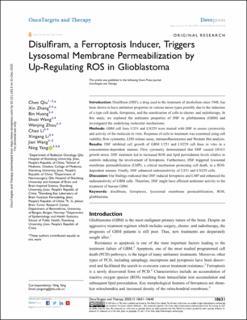| dc.contributor.author | Qiu, Chen | |
| dc.contributor.author | Zhang, Xin | |
| dc.contributor.author | Huang, Bin | |
| dc.contributor.author | Wang, Shuai | |
| dc.contributor.author | Zhou, Wenjing | |
| dc.contributor.author | Li, Chao | |
| dc.contributor.author | Li, Xingang | |
| dc.contributor.author | Wang, Jian | |
| dc.contributor.author | Yang, Ning | |
| dc.date.accessioned | 2021-05-18T12:24:29Z | |
| dc.date.available | 2021-05-18T12:24:29Z | |
| dc.date.created | 2020-12-03T17:31:24Z | |
| dc.date.issued | 2020 | |
| dc.Published | OncoTargets and Therapy. 2020, 13 10631-10640. | |
| dc.identifier.issn | 1178-6930 | |
| dc.identifier.uri | https://hdl.handle.net/11250/2755488 | |
| dc.description.abstract | Introduction: Disulfiram (DSF), a drug used in the treatment of alcoholism since 1948, has been shown to have antitumor properties in various tumor types possibly due to the induction of a type cell death, ferroptosis, and the sensitization of cells to chemo- and radiotherapy. In this study, we explored the antitumor properties of DSF in glioblastoma (GBM) and investigated the underlying molecular mechanisms.
Methods: GBM cell lines U251 and LN229 were treated with DSF to assess cytotoxicity and activity of the molecule in vitro. Response of cells to treatment was examined using cell viability, flow cytometry, LDH release assay, immunofluorescence and Western blot analysis.
Results: DSF inhibited cell growth of GBM U251 and LN229 cell lines in vitro in a concentration-dependent manner. Flow cytometry demonstrated that DSF caused G0-G1 growth arrest. DSF treatment led to increased ROS and lipid peroxidation levels relative to controls indicating the involvement of ferroptosis. Furthermore, DSF triggered lysosomal membrane permeabilization (LMP), a critical mechanism promoting cell death, in a ROS-dependent manner. Finally, DSF enhanced radiosensitivity of U251 and LN229 cells.
Discussion: Our findings indicated that DSF induced ferroptosis and LMP and enhanced the radiosensitivity of GBM cells. Therefore, DSF might have efficient antitumor activity in the treatment of human GBM. | en_US |
| dc.language.iso | eng | en_US |
| dc.publisher | Dove Medical Press | en_US |
| dc.rights | Navngivelse-Ikkekommersiell 4.0 Internasjonal | * |
| dc.rights.uri | http://creativecommons.org/licenses/by-nc/4.0/deed.no | * |
| dc.title | Disulfiram, a ferroptosis inducer, triggers lysosomal membrane permeabilization by up-regulating ROS in glioblastoma | en_US |
| dc.type | Journal article | en_US |
| dc.type | Peer reviewed | en_US |
| dc.description.version | publishedVersion | en_US |
| dc.rights.holder | Copyright the authors. | en_US |
| cristin.ispublished | true | |
| cristin.fulltext | original | |
| cristin.qualitycode | 1 | |
| dc.identifier.doi | 10.2147/OTT.S272312 | |
| dc.identifier.cristin | 1855985 | |
| dc.source.journal | OncoTargets and Therapy | en_US |
| dc.source.40 | 13 | |
| dc.source.pagenumber | 10631-10640 | en_US |
| dc.identifier.citation | OncoTargets and Therapy. 2020, 13, 10631—10640. | en_US |
| dc.source.volume | 13 | en_US |

